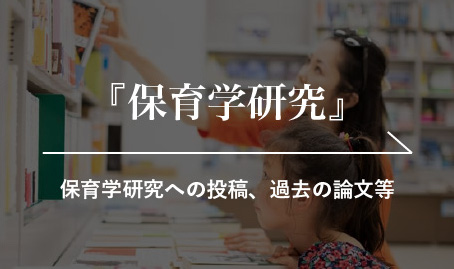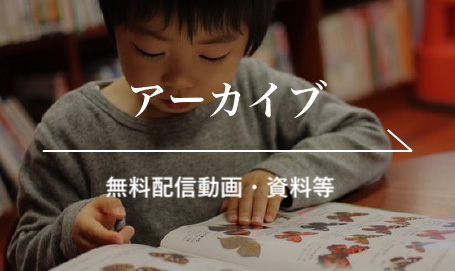< VOLUME 46, No.2 >
Yoshimura Kaori, Yoshioka Akiko. The Relationship between a Child Care Worker and a Researcher in Their Narratives : From a Clinical Viewpoint of Child Care.
Research on Early Childhood Care and Education in Japan, 2008, 46(2), 148-157.
This study is a cooperative study conducted by a child care worker and a researcher. The researcher observed her care activities and after each session of child care, they discussed her care. This study analyzed their narratives to examine how the child care worker made decisions about her child care. The result shows that there are two stages in the narratives. In the first stage; both the child care worker and the researcher were in a psychologically equal position, or a sort of “parallel relationship,” as the child care worker narrated what she thought in her daily care. This stage is based on their wish to understand each other. This relationship led to what might be termed “the conversational relationship.” In the conversational relationship, they formed cooperative contexts for child care. These features suggest that such a relationship between a child care worker and a researcher is as important in a clinical narrative setting as in a conference for child care.
Keywords: narrative, forming context, parallel relationship, conversational relationship, clinical listener
—————–
Kanazawa Taeko. On Spinning a Thread of Childcare with Collaboratore : The Cooperation between Different Job Types of Childcare Sites in Bologna.
Research on Early Childhood Care and Education in Japan, 2008, 46(2), 158-168.
This study is based on my five-month observation of child care centers and kindergartens in Bologna. These places for children have special staff to support childcare called collaboratore. The observation reveals how they were involved in childcare and how they collaborated with other professional staff. They were working as a team and were very proud of their jobs. Child care requires collaboration with many people from various professions. Each professional should make not a vertical relationship with children but a cooperative relationship with other professionals placing emphasis on children. In this way, the idea of each professional would contribute to better care for children. To achieve such a relationship, it is essential to provide an opportunity to facilitate communication among different professions and recognize that each professional is equally responsible for and proficient in childcare.
Keywords: collaborator, collaboration and cooperation, communication among different professions, observation record, Bologna
—————–
Okada Tatsumi, Nakatsubo Fuminori. The Process of Understanding a Child : Focusing on Information from Colleagues.
Research on Early Childhood Care and Education in Japan, 2008, 46(2), 169-178.
The objective of this study is to clarify the influence of colleagues in childcare upon the process of understanding a child. The first author, a kindergarten teacher, analyzed her journal of childcare and information from her colleagues with the second author, a researcher, using a qualitative analysis methodology. The results are as follows. First, there exist both verbal and nonverbal types of information. Second, there are four types of information to modify the teacher’s understanding. Third, the information has both quantitative and qualitative effects. The colleagues have a great influence on structuring the teacher’s understanding of a child by sharing information about events related to the child, their views and values to him/her, and so on.
Keywords: journal of childcare, understanding of a child, information, colleagues, Auto-ethnography
—————–
Ohta Mitsuhiro. Supporting Nursery Teachers as Childcare Professionals : Mutual Support among Nursery Teachers in a Local Childcare Support Activity.
Research on Early Childhood Care and Education in Japan, 2008, 46(2), 179-188.
The purpose of this study is to examine various supports for childcare personnel in local childcare support activities and to clarify the possible supports and their characteristics. Fieldwork and interviews indicate that the situation of supporting the childcare personnel can be best understood from multidimensional viewpoints. Nursery teachers can support each other based on their personal relationships and a daycare center can provide organizational and structural support. This support should be clearly described as to purpose and method, and implemented in concrete ways so that childcare personnel may enhance the quality of their childcare. Structure and planning are necessary for the support management.
Keywords: local childcare support activities, mutual support of childcare teachers, childcare management
—————–
Nomoto Shigeo. When Kindergarten Teachers and Day-care Center Teachers Overcome “Yukizumari”, a Hard Situation, in Childcare : The Meaning of Mutual Support between Kindergarten Teachers and Day-Care Center Teachers in Early Childhood Care and Education Practice.
Research on Early Childhood Care and Education in Japan, 2008, 46(2), 189-200.
The purpose of this paper is to clarify mutual support between kindergarten teachers and day-care center teachers. This mutual support is clearly necessary when each individual faces a very hard situation beyond his/her ability to manage in childcare practice. The author examines two cases in which “Yukizumari”, a hard situation, was experienced in childcare practice and overcame it. The result indicates that a good rapport that allows them to whine is the basis for mutual support in their workplace. And, the same mutual support was also seen among colleagues in a study group outside the workplace. It is also revealed that young children who displayed difficult problems provide an opportunity to promote partnership and collaboration among teachers.
Keywords: kindergarten teacher and day-care center teacher, mutual support, “Yukizukari” in early childhood care and education practice, partnership, collaboration
—————–
Toda Masami. The Structure of Problems about Cooperation of Childcare Activities.
Research on Early Childhood Care and Education in Japan, 2008, 46(2), 201-211.
The purpose of this article is to clarify the structure of problems entailed in cooperation of childcare activities revealed in a theoretical examination and a case study. Conflicts of values by which childcare activities are evaluated and cooperation of childcare activities are placed on coordinate axes and the relationship is structured for a theoretical examination. The case study reveals specific problems about cooperation of childcare activities. The result of the theoretical examination and the case analysis suggests that we need: 1) to recognize that mere formal cooperation can negatively affect the children involved 2) to solve value differences not by avoiding conflicts, but by reserving extra time to find solutions 3) to realize and verbalize the activities in childcare. 4) the meaning of the existence of a third-person stance.
Keywords: bases for a decision on an act, conflict of values, cooperation, structure of problems
—————–
Takazakaura Ayako. Relationships of 3-year-old Children in Terms of Ne-utterances during Their Play.
Research on Early Childhood Care and Education in Japan, 2008, 46(2), 214-224.
This study focused on ne-utterances during play and analyzed the connection between these utterances and how they are used in relationships among 3-year-old children. Children often utter Ne, which tacitly indicates the state of their relationships. Interactions of 3-year-old children in a nursery school were recorded on videotape during their play. First, this study categorized how ne-utterances were used. Second, this study chose two children who used more ne-utterances than others in the class, and examined how the type and number of their ne-utterances changed over a period of time. We found that (I) ne-utterances could be categorized into 15 functions; the “connect interval of speech” function was used the most frequently and affected continuing interactions; (II) changes in the children’s relationships influenced the type and number of ne-utterances; and (III) ne-utterances are a clue for analyzing children’s relationships.
Keywords: ne-utterances, play, relationships, 3-year-olds
—————–
WadaYukiko. Nursery Practice for Children with Disabilities Using “Warabeuta” : A Case Study through Structural Analysis of Play.
Research on Early Childhood Care and Education in Japan, 2008, 46(2), 225-234.
This study based on observation of my nursery practice of playing Warabeuta, Japanese traditional children’s songs, for children with disabilities. Warabeuta are songs sung as part of a game. First of all, I described the activities of an autistic boy in my nursery practice. Then I observed the reactions of the autistic child using the ideas of F. Koizumi and T. Kojima’s Warabeuta music theory and K. Nishimura’s structural analysis of play. The study shows the value of using Warabeuta as a means of giving children the satisfaction of playing together. The result reveals the original form Warabeuta play. The boy clearly enjoyed the singing and playing with the other children, and developed friends among the other children.
Keywords: Warabeuta, nursery for children with disabilities, structural analysis of play
—————–
Ando Satoko, Aramaki misako, Iwafuji Hiromi, Niwa Sagano, Sunagami Fumiko, Horikoshi Norika. Mothers’ Feelings about Child-Rearing and Depressive Symptoms : Focusing on the Use of Child-Rearing Support in Kindergartens.
Research on Early Childhood Care and Education in Japan, 2008, 46(2), 235-244.
The purpose of this study is to investigate the occurrence of depressive symptoms among kindergarteners’ mothers, to examine associations between mothers’ feelings about child-rearing and depressive symptoms, to identify associations between such mothers’ feelings and depressive symptoms, and to explore the use of extra child-care-hours at kindergartens by mothers. A questionnaire survey conducted in kindergartens revealed that 18.4% of 2,976 non-working mothers showed high scores on depressive symptoms, which is almost the same rate as postpartum depression. The result also revealed a correlation between depressive symptoms and feelings about child-rearing. Mothers with totals indicating higher perceived burdens of child-rearing tended to use extra child-care-hours more frequently and to feel less guilty about their childrearing methods than mothers having a low perceived sense of child-rearing burdens. We proposed screening and support systems for depressive mothers of kindergarteners.
Keywords: depression, feeling about child-rearing, child-care support, extra child-care-hours, kindergartens
—————–
Kawabe Takako. A New Recording Method for a Daily Plan for Early Childhood Education : The Role of “Activity Map Recording”.
Research on Early Childhood Care and Education in Japan, 2008, 46(2), 245-256.
Preschool and nursery teachers keep daily official records for children. These records focus on an individual child rather than on the group dynamics of children. These individual records, however, may not be useful enough in themselves for making a daily plan. Therefore, we developed a new recording method called “Activity Map Recording” This type of recording can reveal information about children’s group dynamics by mapping how children use space. Using this information, pre-school and nursery teachers will be able to improve daily plan.
Keywords: daily official record, Activity Map Recording, daily plan, space
—————–
Koyama Mizue. The Formation Process of ‘Story-Telling’ in Kindergartens During the Taisho and Early Showa Periods : Focusing on the Practice and Study in Osaka Municipal Kindergartens.
Research on Early Childhood Care and Education in Japan, 2008, 46(2), 257-266.
During the Taisho period, ‘Ohanashi’, Story-telling, was introduced as a general term referring to children’s stories. The purpose of this study is to examine the influence of the theory of ‘storytelling’ in the kindergarten education in Osaka, and to elucidate the characteristics of ‘Ohanashi’ formed in the early Showa period by revealing how it was studied and practiced. The results of this study are as follows: 1) Kindergarten teachers selected various kinds of stories from the viewpoint of giving joy to kindergarten children. 2) They created and narrated stories based on the children’s lives. 3) The Emotional interaction between kindergarten teachers and children was enhanced through the ‘storytelling’ process in kindergarten education.
Keywords: kindergarten in Osaka, storytelling, story, the practice and study, the Taisho and early Showa period
—————–
Kishaba Isoko. A study on Zenrin Kindergarten in Okinawa 2 : Focusing on the Process of Popularization.
Research on Early Childhood Care and Education in Japan, 2008, 46(2), 267-276.
This research aims to clarify the process of the popularization of kindergarten education in Okinawa prefecture by analyzing Zenrin Kindergarten, and is a follow-up to previous research on the same subject. It was revealed that the kindergarten and the Naha Baptist Church strongly influenced each other. Zenrin Kindergarten’s “Mothers’ Meeting” was held in coordination with the Church’s “Sunday School” and “Women’s Meeting”. The kindergarten assumed the role of “Neighborhood Improvement Plant” based on Christ’s message to love and serve one another. These meeting activities added a social value to the concepts of “woman and child.” at a time when Okinawan society was seeking a new system of morals and values. The recognition of children and women as human resources activated the activities of “Children’s Meetings” in the Taisho Period.
Keywords: Bible Woman, Neighborhood Improvement Plant, Baptist, Sunday School, Mother’s Meeting
—————–
Ueno Yoko, Ishikawa Yuka, Iseki Reiko, Tabuchi Kumiko, Nishihara Mayumi, Masatsugu Karen, Miyazaki Kiyono. Multicultural Childcare in Nagasaki : Current Circumstances and Future Perspectives.
Research on Early Childhood Care and Education in Japan, 2008, 46(2), 277-288.
This paper continues our research into pre-school care for foreign children in Nagasaki city, reporting the results of interviews with selected nursery schools and kindergartens, and with foreign parents of children attending those facilities. The first part reviews previous research and highlights relevant issues. The second part examines foreign parents’ largely positive perceptions of the childcare their children received. The third part examines the situation from the perspective of the facilities themselves in relation to intercultural understanding of the caregivers’ intercultural understanding of Japanese children and foreign parents and children’s acclimatization to Japan. The fourth part examines the potential for miscommunication between foreign parents and caregivers. The fifth part considers issues relating to prejudice and the need for anti-bias awareness. The sixth part proposes attitudes and practices advisable for childcare workers in order to promote multicultural education.
Keywords: multicultural education, early childhood, foreign children, intercultural understanding
—————–
Fujii Hodaka. Assurance of Access to Nursery School in France : Analysis of the Intention of Legislation.
Research on Early Childhood Care and Education in Japan, 2008, 46(2), 289-298.
The nursery school in France generally has a characteristic of a very high ratio of attendance which is 100% of three to five year old children and enrollment of two year old children in the educational priority area. This is partially a result of legislation which assures the access of all infants to such schools. The law introduced by Haby (1975) established the assurance of access for all five year old children and set a goal to compensate for inequality for all nursery schools. Another law introduced by Jospin (1989) resolved that all three year old children in all areas of France should have equal access to nursery schools, and created an affirmative action plan for two year old children to fight against the inequality caused by their social environment.
Keywords: nursery school (école maternelle) in France, equal opportunity of early childhood education, affirmative action of two year old children
—————–
Takahashi Tamiko. Spread of Emergency Education for Earthquakes for Young Children Cooperating with the Community.
Research on Early Childhood Care and Education in Japan, 2008, 46(2), 299-309.
In Okayama City, earthquake education for kindergartners was focused mainly on how to react and evacuate when an earthquake occurs. This study proposes a new earthquake educational system for young children utilizing local resource persons and agencies. It also recommends specific activities to increase awareness that can prevent some of the tragic consequences of earthquake disasters that affect young children. These activities use both play and simulated experience and are undertaken with the participation of their parents. These activities encourage young children’s versatility and ability to adapt to situations.
Keywords: young children, earthquake, disaster prevention education, cooperation with a local community spread of education
—————–









